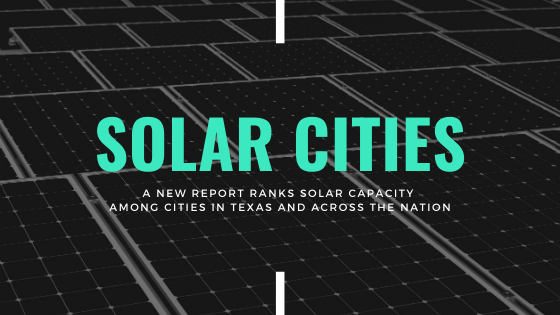Almost 90 percent of surveyed cities more than doubled their total installed solar photovoltaic capacity between 2013 and 2019.
________________________________________________
 Austin, San Antonio and Houston were among Texas cities to significantly increase their use of solar power during 2019, with each rising in nationwide rankings, according to a new survey.
Austin, San Antonio and Houston were among Texas cities to significantly increase their use of solar power during 2019, with each rising in nationwide rankings, according to a new survey.
The survey also found the city of Dallas increased its solar capacity and increases among several smaller Texas municipalities. Released by the Environment Texas Research & Policy Center, an environmental activist group, the May 2020 report examined solar power changes among the nation’s major cities over the past seven years.
The analysis found that almost 90 percent of the surveyed cities had more than doubled their total installed solar photovoltaic capacity between 2013 and 2019. Los Angeles finished No. 1 in total solar energy capacity installed, while Honolulu placed first for solar energy capacity measured on a per-capita basis.
San Antonio led all Texas cities for per-capita solar capacity within city limits, and placed fifth nationwide. Austin placed second in Texas for per-capita capacity and 14th nationwide. San Antonio and Austin operate the state’s first and second largest municipal-owned utilities, respectively.
However, by a slightly different metric — the amount of solar power under contract both inside and outside city limits, measured on a per-capita basis — Austin ranked higher than San Antonio and first among all municipal utilities nationwide. By that metric, San Antonio ranked second among the nation’s municipal utilities.
The report found per-capita solar capacity in Houston doubled for the second year and in Dallas increased by 24 percent.
The report’s authors said the numbers show substantial solar progress among Texas cities. “We continue to see significant growth in solar energy in cities across Texas — Texans of all shapes and sizes are going solar, and that’s great news for our environment and economy,” said Luke Metzger, executive director of the Environment Texas Research and Policy Center.
But Metzger also warned that the COVID-19 pandemic has placed that progress at risk, and that policy makers should make smart policy choices going forward. Among his group’s recommendations are the implementation of new solar access ordinances, ambitious solar-use goals and encouraging Texans to install solar panels on new homes.
Among other report findings:
- San Antonio’s solar energy capacity increased 36% during 2019 to a total of 254.47 megawatts (MW).
- With 50.5 MW installed, El Paso ranked ahead of Dallas and Houston for solar PV capacity within city limits, measured on a per-capita basis.
- Solar capacity in Houston increased from 20.6 megawatts in 2018 to 42.53 MW in 2019.
- Fort Worth ranked fifth in Texas for installed solar capacity with 28.72 megawatts, which exceeds installed capacity for adjacent Dallas.
- Dallas ranked 6th place 27.36 MW. However, the increased use of per-capita solar pushed Dallas up from 26th to 23rd place nationally, and ahead of Seattle, Kansas City and Raleigh.
The full report can be found here. Texas specific rankings can be found in Appendix C.

